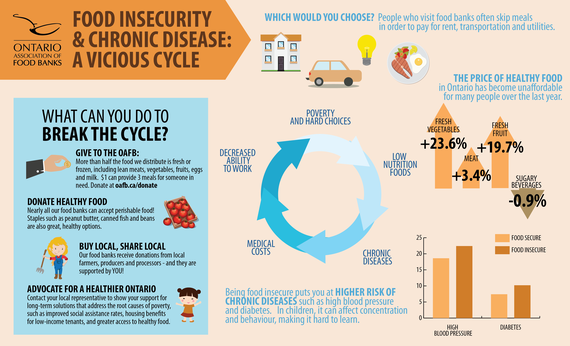
On Thursday, for World Health Day, the World Health Organization (WHO) released its first global report on diabetes, announcing that the number of people living with diabetes worldwide has almost quadrupled since 1980, growing from 108 million to 422 million adults. In Canada, it's estimated that three million adults have diabetes, and costs our health-care system $3-billion a year. What's more, this number is expected to grow by 40 per cent in the next 10 years.
While there are many risk factors for diabetes that you can't control, such as age, genetics, and ethnicity, there are some that you can. A healthy diet and active lifestyle plays a large role in both preventing and managing diabetes; unfortunately, good food isn't accessible to everyone.

The Canadian Diabetes Association (CDA) reports that rates of diabetes are disproportionately higher among low-income individuals and First Nations people, two demographics that also face high rates of food insecurity.
It's easy to tell someone to "just eat healthier," but it is a lot more difficult to actually put into practice, especially if you can't afford it. Poverty can easily trap someone into a cycle of food insecurity and poor health.
When facing a very tight budget, food is often the budget line that gets cut in order to afford rent or hydro: you can skip a meal for a day or two and still be OK, but there are much more immediate consequences to not paying your landlord.
Instead, people in this situation often turn to food with higher calories and lower nutritional value to fill the empty feeling in their stomachs. Prices of healthy food in Ontario have skyrocketed over the last year: fresh fruit has jumped by 19.7 per cent since 2015, and fresh vegetables by 23.6 per cent, whereas the cost of candy has only risen by 0.4 per cent, while non-alcoholic beverages (such as pop) have actually dropped by 0.9 per cent.
People facing tough choices every single day -- rent or electricity? food or medicine? -- have high levels of stress. Stress can affect both your ability to take care of yourself and trigger high levels of blood glucose. Since diabetes is a disease in which your body isn't able to manage blood sugar levels, this can have even more adverse consequences.
All of these complications can impact ability to work and take care of yourself, thus locking people into a vicious cycle that is hard to escape.
All these things combined put low-income and First Nations people at a high risk for diabetes. Managing diabetes is itself expensive: beyond just the dietary changes required to keep it at bay, there is also the cost of prescription, supplies and equipment. Yet those who are low-income also often do not have enough or any insurance to cover these costs, because they work in precarious, low-wage jobs without benefits.
Diabetes, left untreated and unmanaged, can have many adverse consequences: heart disease, stroke, nerve damage, poor vision, kidney failure, limb amputation and much more. People with diabetes also have poorer mental health, with higher rates of depression and anxiety, and feel stigmatized and alone.
All of these complications can impact ability to work and take care of yourself, thus locking people into a vicious cycle that is hard to escape.
So what can we do about this problem?
Food banks are doing their part: each year, the Ontario Association of Food Banks strives to provide better-quality food to food banks, and last year over half of the food we sent out was fresh or frozen. This is in large part due to amazing partnerships with producer groups across the province that allow us to send out milk, eggs, pork, beef, turkey, lamb, and chicken to our members across the province.
In order to improve people's health, we need to improve their income.
We also successfully worked with the provincial government to introduce a tax credit for farmers who donate fresh food to food banks, to assist farmers who have long shown great generosity to the food banks in their communities. Further, we provide grants each year so food banks can purchase refrigerators and freezers and expand their ability to accept fresh and frozen food donations.
One of our member food banks, the Regional Food Distribution Association in Thunder Bay, is piloting a diabetes intervention program in tandem with dieticians from their local health sciences center. Given that their First Nations community has a diabetes rate of 60 per cent, this is a much-needed program.
Yet, despite these amazing strides in the food banking community, we acknowledge there is still much more that needs to be done. In order to improve people's health, we need to improve their income.
The Director-General of the WHO, Margaret Chan, is calling for a large change in the way we approach diabetes: "Even in the poorest settings, governments must ensure that people are able to make these healthy choices and that health systems are able to diagnose and treat people with diabetes." Toronto doctor Gary Bloch prescribes his patients income as a treatment to their ailments, and finds that when their incomes rise, there is an "amazing stabilization" in their health situations.
The province needs to take note of this, and take big steps to address these issues. In the latest provincial budget, we saw small increases to social assistance rates, improvements to grants for post-secondary students, and a commitment to developing to a housing benefit for low-income tenants. In addition, they promised a Basic Income pilot project, which has great potential to address poverty. These are encouraging early signs, and we have hope that greater action is still to come.
While action is being taken by many people on the issue of food insecurity, poverty and chronic disease, there is still such a large gap between where we are and where we need to be.
In the meantime, you can take action to break this cycle of food insecurity and poor health in a number of ways. Nearly all our members can accept fresh and frozen food donations -- just contact your local food bank to see how you can help. You can donate to the Ontario Association of Food Banks, and turn every $1 you donate into three meals.
Share articles and have discussions with friends and family about how we can better address poverty in this province. And continue to be engaged with your government by calling, emailing, or tweeting your MPPs to ensure they are doing all they can to help those in great need.
While action is being taken by many people on the issue of food insecurity, poverty and chronic disease, there is still such a large gap between where we are and where we need to be, and it is up to all of us to help shape that future.
Ashley Quan is the Coordinator of Communications and Programs at the Ontario Association of Food Banks.
Follow HuffPost Canada Blogs on Facebook
ALSO ON HUFFPOST:
